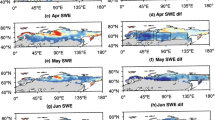Summary
The surface energy balance in a small permafrost watershed near Fox, Alaska, was calculated for the snow melt period, which started in 30 March and ended on 22 April 1980 with the total disappearance of the snow cover. The snow cover of 1979/80 was light with 70 mm water equivalent. Heat sources were the radiation balance (67%) and the sensible heat flux (33%). This energy was used for melting of the snow cover (22%), evaporation (78%), and less than 1% was used for warming of the snow and soil.
Two significant features are apparent in this heat balance:
-
1.
The latent heat flux is strongly negative, which means that evaporation greatly exceeds condensation due to the excessive dryness of the air after a cold winter. As evaporation requires more than 8 times the energy needed for melting of a snow cover, this slows down the disappearance of the snow cover. During the spring of 1980, more than 1/3 of the snow cover evaporated and did not contribute to the run-off.
-
2.
The sensible heat flux contributed a relative high amount of 1/3 of the total heat source. This was caused by fairly warm air which moved into the area and which also brought a relatively high amount of cloudiness (April 1980, 69%). This cloudiness in turn caused the lowest positive value of the net radiation when compared to 5 other snow melt study experiments.
Zusammenfassung
In einem kleinen permafrostdurchzogenen Einzugsgebiet in der Nähe von Fox, Alaska, wurde der Wärmehaushalt für die Schneeschmelzperiode, die am 30. März begann und am 22. April 1980 mit dem totalen Abbau der Schneedecke endete, berechnet. Die Schneedecke des Winters 1979/80 war mit 70 mm Wasseräquivalent leicht. Wänne spendete die Strahlungsbilanz (67%) und der sensible Wärmestrom (33%). Diese Energie wurde zum Schmelzen der Schneedecke (22%), zur Verdunstung (78%) und zum Erwärmen der Schneedecke und des Bodens — weniger als 1% — gebraucht. Zwei Ergebnisse dieser Wärmebilanzstudie sind besonders erwähnenswert:
-
1.
Der latente Wärmestrom ist stark negativ, was besagt, daß die Verdunstung die Kondensation stark überkompensiert, da die Luft nach dem kalten Winter noch sehr trocken ist. Da mehr als 8mal soviel Energie zur Verdunstung als zum Schmelzen der Schneedecke gebraucht wird, verlangsamt sich der Abbau der Schneedecke. Im Frühjahr 1980 verdunstete mehr als 1/3 der Schneedecke und konnte somit nicht zum Abfluß beitragen.
-
2.
Der sensible Wärmestrom stellte mit 1/3 der totalen Wärmespenden einen recht hohen Anteil dar. Das ist durch relativ warme Luft, die ins Innere von Alaska transportiert wurde, verursacht, die ferner starke Bewölkung mit sich brachte (April 69%). Die starke Bewölkung verursachte auch die niedrigste positive Strahlungsbilanz im Vergleich zu 5 anderen Studien, welche in der Arktis oder Subarktis durchgeführt worden sind.
Similar content being viewed by others
References
Ambach, W.: Untersuchungen zum Energieumsatz in der Ablationszone des grönländischen Inlandeises. Meddelelser om Grønland. Bd. 174, Nr. 4 (1963).
Billelo, Michael, A.: Survey of Arctic and Subarctic Temperature Inversions. U.S. Army Material Command, Cold Regions Research and Engineering Laboratory. Report TR161, 1966.
Chang, Jen-Hu: Climate and Agriculture, 304 pp. Chicago: Aldine Publishing Co. 1971.
Davenport, A. G.: Rationale for Determining Design Wind Velocities. J. Am. Soc. Geo. Eng. (Strmt. Div.)86, 39–68 (1960).
Deacon, E. L., Webb, E. K.: Small-Scale Interactions. The Sea, Ch. 3, pp.43–87. New York: Interscience 1962.
Funk, J. P.: A Note on Long Wave Calibration of Convectively Shielded Net Radiometers. Arch. Met. Geoph. Biokl., Ser. B11, 70–81 (1961).
Geiger, R.: The Climate Near the Ground, 611 pp. Cambridge, Mass.: Harvard University Press 1966.
Gold, L. W., Williams, G. P.: Energy Balance During the Snow Melt Period at an Ottawa Site. UGGI, AIRS. Assemblée générale de Helsinki, 1960. Commission des Neiges et Glaces, pp. 288–294, 1961.
Grant: Description of Recorder, Sensors, and Playback Units. Grant Instruments Ltd. Barrington, Cambridge CB2SQZ, England 1979.
Kane, D. L., Bredthauer, St. R., Stein, J.: Subarctic Snowmelt Runoff Generation. Proc. Amer. Soc. Civil Engineers. Technical Council on Cold Regions Engineering. Seattle, April 1981. (In press.)
Lettau, H.: Atmosphärische Turbulenz. Leipzig: Akademische Verlagsgesellschaft 1939.
Lettau, H.: Isotropic and Non-Isotropic Turbulence in the Atmospheric Surface Layer. Bedford, Mass., Geoph. Res. Rect., U.S. Air Force Cambridge Research Center (Geoph. Res. Paper No. 1), 1949.
Prandtl, L.: Führer durch die Strömungslehre, 407 pp., 4. Aufl. Braunschweig: Vieweg und Sohn 1956.
Searby, H. W.: Climates of the States, Alaska. Climatology of the United States, No. 60–49. Dept. of Commerce, U.S. Weather Bureau, 23 pp., 1968.
Untersteiner, N.: On the Mass and Heat Budget of Arctic Sea Ice. Arch. Met. Geoph. Biokl., Ser. A12, 151–182 (1961).
Webb, E. K.: Aerial Microclimate in Agricultural Meteorology. Met. Monographs6, 27–58 (1965).
Weller, G., Holmgren, B.: The Microchmates of the Arctic Tundra. J. Appl. Met.13, 854–862 (1974).
Wendler, G.: The Heat Balance at the Snow Surface During the Melting Period (March–April 1966) Near Fairbanks, Alaska. Gerlands Beitr. Geoph.76, 453–460 (1967).
Wendler, G., Nicpon, P.: Low Level Inversion in Fairbanks, Central Alaska. Mon. Weath. Rev.103, 34–44 (1975).
Wieringa, J.: Representativeness of Wind Observations at Airports. Bull. Amer. Met. Soc.61, 962–971 (1980).
Author information
Authors and Affiliations
Additional information
With 10 Figures
Rights and permissions
About this article
Cite this article
Eaton, F., Wendler, G. The heat balance during the snow melt season for a permafrost watershed in interior Alaska. Arch. Met. Geoph. Biocl. A. 31, 19–33 (1982). https://doi.org/10.1007/BF02257739
Received:
Issue Date:
DOI: https://doi.org/10.1007/BF02257739




